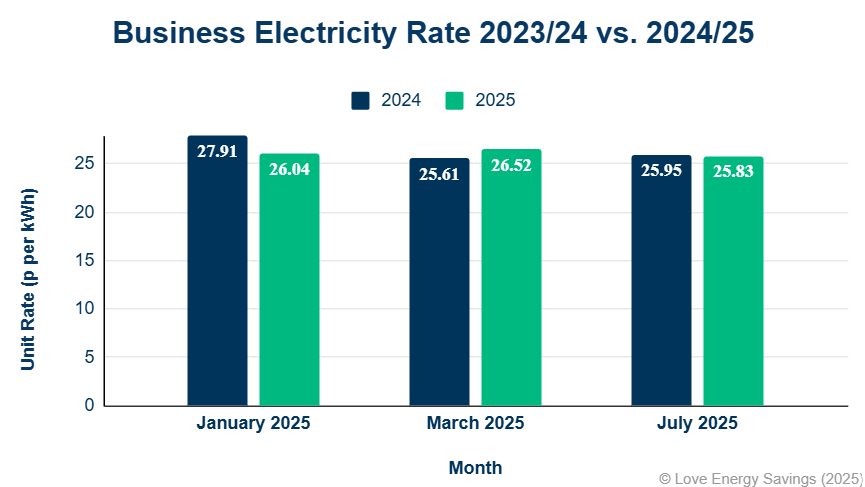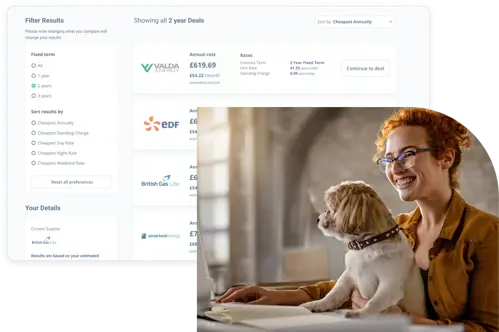Compare Business Electricity Rates
Save time and money - see competitive electricity rates in just 30 seconds.
![]() Compare and switch online
Compare and switch online
![]() Join 500,000+ businesses saving over £150M
Join 500,000+ businesses saving over £150M
![]() See how much you could save on bills
See how much you could save on bills
![]()
Comparing rates with Top UK Suppliers
Comparing rates with Top UK Suppliers






How To Compare Business Electricity Rates
Should You Switch Business Electricity?
Business electricity rates are much more competitive. In fact, prices have dropped by a massive 62% since October 2022.
Cornwall Insight has now predicated that wholesale prices will remain steady, with only slight changes in the coming months.
With that in mind, many businesses are choosing to lock in their business electricity rates. This can offer certainty and stability in the future.
When you compare business electricity prices with us, you can view live rates from a panel of trusted suppliers. Secure your new tariff today.
Why Switch Business Electricity With Us?
There are many reasons to use our business electricity comparison & switching service over any other. When switching with us, you have the unique option of completing your business electricity switch fully online. You can secure your new deal without the need for a 40 minute phone call.
If you'd prefer to speak with one of our business electricity experts, you can do that instead. The option is entirely yours!
17 yrs
Providing exceptional service and expertise
500k+
Businesses have saved with us
£150M+
Total savings on bills for our customers

Rated excellent by our customers
Commercial Electricity Rates by Business Size 2025
A range of factors can influence business electricity prices. This can include your location, usage, and the size of your business.
To offer a guide when switching, we've provided the average electricity prices by business size. These prices are based on a 2-year fixed rate deal.
|
Business size |
Annual Usage |
Unit Price per kWh |
Daily Standing Charge |
Cost Per Year |
Compare Live Deals |
|---|---|---|---|---|---|
|
Micro Business |
up to 5,000kWh |
27.1p |
40.5p |
£824.10 |
|
|
Small Business |
5,000-15,000kWh |
26p |
49p |
£2,774.79 |
|
|
Medium Business |
15,000-25,000kWh |
25.6p |
70.3p |
£6,668.80 |
|
|
Large Business |
25,000-50,000kWh |
25.5p |
1161p |
£10,149.52 |
Data correct as of July 2025. Annual cost based on a 2-year contract and the median kWh usage within each business size banding. These prices reflect a live market and are subject to fluctuation.
Tariffs are regularly updated and the best way to find the latest deals is to compare commercial electricity prices.
Your Unit Rate and Standing Charge Explained
Your unit rate is the cost of each kilowatt hour of electricity your business uses. Businesses with high consumption rates will generally pay slightly cheaper unit rates than smaller businesses.
Your standing charge covers the cost of maintaining the energy supply. This includes using and maintaining the energy supply network and transporting electricity to your premises.
Business Electricity Prices per kWh
Kilowatt hour (kWh) prices are essential to how you're charged by suppliers. This is the unit of measurement used to display your unit rate. This cost depends on several factors unique to your business.
The cheapest business electricity supplier for one business may not be the cheapest supplier for another. With Love Energy Savings, you can compare business electricity prices from a wide range of trusted suppliers quickly and easily.
Fixed Rate Tariff
A fixed rate tariff is one of the most popular business electricity tariff options. With a fixed rate tariff, you agree to pay a fixed unit price and a standing charge. This price can be locked in for up to 5 years, depending on your provider.
See fixed rate business electricity tariffs
A fixed-rate business electricity tariff is great for companies who want to maintain control of their bills and budgeting. Your fixed price deal will protect you from any electricity price increases during your contract.
Variable Rate Tariff
With a variable rate tariff, your unit rate will change depending on the wholesale prices. This can be a good option for companies who want to take advantage of any reductions in business electricity prices.
Scottish Power typically offer variable rate contracts as standard.
See variable rate business electricity tariffs
However, it's worth keeping in mind that you prices can go up at any point during your contract. If you're comfortable with changing prices, a variable tariff can be a good option.
Rollover Tariff
When a new business electricity contract has not been agreed, you may be placed on a rollover contract. This will be for a fixed period (usually one year) and is legally binding. Sometimes unit rates are more expensive and hold you back from getting cheaper rates elsewhere.
Green Business Electricity Tariff
More and more businesses are moving towards sustainable sources. Green business electricity tariffs are becoming a popular choice for environmentally conscious companies. An increasing number of business electricity suppliers are now offering green tariffs. This has given a much greater choice for small and large businesses.
Pass Through Tariff
A pass-through tariff is a little more complicated than other business electricity tariffs. It separates your bill between fixed wholesale rates and other rates. Other rates are those associated with National Grid levies and other network costs. They can vary several times per year. These tariffs are often best suited to active electricity buyers that regularly control the tariff.
Deemed Rate Tariff
Businesses that have never taken out a business electricity contract and have not agreed to one will be placed on a deemed rate tariff. These are the most expensive rates on the market.
Flexible Tariff
Large consumption organisations may prefer to purchase all their electricity supply in advance. Doing this will give businesses access to wholesale market rates, bypassing some of the retailer costs.
Each tariff type offers its own benefits, from fixed costs over a certain period to renewably sourced. For those reasons, it is important to thoroughly compare business electricity tariffs. This will help you identify the correct tariffs to maximise savings.
Our Business Electricity Suppliers
At Love Energy Savings, we work with a wide range of business electricity suppliers. This allows us to offer our customers access to exclusive deals with trusted providers.
When you compare with us, we’ll take care of the process of your switch to get your new tariff set up without the hassle. We work with businesses of all sizes. So, whether you’re searching for a supplier offering small business support, or a half-hourly contract, we’ve got you covered.
If you’re ready to switch commercial electricity suppliers, you can get your quote today by using the table below.
| Energy Supplier | Supplier Ratings | Business Comparison |
|---|---|---|

|




|
View Tariffs |

|




|
View Tariffs |

|




|
View Tariffs |

|





|
View Tariffs |

|





|
View Tariffs |

|




|
View Tariffs |

|





|
View Tariffs |

|

|
View Tariffs |
Cheapest Business Electricity Rates By Supplier
The price of business electricity for your organisation varies on multiple factors. For example, suppliers may offer large business electricity users cheaper unit rates through half hourly meters.
Below we have provided an example of a business with 25,000 kWh of annual electricity usage. This is based on a 2-year fixed-rate deal.
This aims to provide some guidance on average costs. However, business electricity rates do change daily. We would always advise you to use our comparison engine to find today's live rates for an accurate quote.
Click the supplier's name to find out more about them.
|
Supplier |
Standing Charge (p) |
Unit Rate |
Annual Cost |
Compare Live Deals |
|---|---|---|---|---|
|
62p |
27.3p |
£7,054.34 |
||
|
42p |
26.7p |
£6,821.51 |
||
|
74.4p |
26.1p |
£6,784.71 |
||
|
90.3p |
24.6p |
£6,480.66 |
||
|
64.5p |
25.5p |
£6,607.21 |
Want To Stay With Your Current Business Electricity Supplier?
It’s hassle-free, easier and quicker to recontract with your current business electricity supplier. This is a good choice for your company if you want to avoid any lump sum final bills and additional paperwork.

Finding the Best Business Electricity Supplier for You
Certain business electricity suppliers may be more suited than others depending on the sector you operate in. Whilst your energy bills are increasing in the current crisis, business energy customers can still switch tariffs.
Business owners are switching suppliers to protect themselves against future price increases rather than looking for immediate savings. Choosing the right gas and electricity supplier has also become much more important. If you require larger energy consumption, we also have tendering processes through our energy procurement services.
Our experts will advise you on everything from your smart meter, energy use, greener energy, finding the right fixed deal and the business energy price guarantee. Alternatively, if you know what you're looking for, you can look to switch and secure your energy bills completely online at a time that suits you.
What Happens if My Business Electricity Supplier Goes Out of Business?
Ofgem will step in and appoint a licensed energy supplier. You do not need to do anything but wait for your new supplier to contact you. You will not lose your electricity supply.
When switched over to your new supplier, you will need to continue to pay any outstanding debts to them if your account holds an outstanding balance.
Unfortunately, businesses are not protected by the Ofgem Safety Net so it is unlikely you will get any money back from built up credit on your account. Transferring credit over is at your new suppliers discretion.
You should take the following actions if your supplier goes bust:
- Arrange to take regular meter readings
- Do not switch energy suppliers during this period
- Wait for your new energy company to get in touch

Is The Cost Of Business Electricity Getting Cheaper?
The price of business electricity has been a hot topic and an area of concern since the energy crisis. However, electricity unit rates have steadied after a fall from the peak of the energy crisis
We pulled together the three cheapest business electricity tariffs for each of 3 months comparing 2024 to 2025. These prices show that costs have dropped slightly from 27.91p per kWh back in January 2024 to 25.83p per kWh in July 2025. Predictions suggest that prices will remain around this level for the foreseeable future. Although, it's worth keeping in mind that things could change overnight as we have seen in the past.

Commercial Electricity Rates for Large Businesses
We offer bespoke quotes for large businesses seeking to switch electricity. This includes single-site companies and servicing multi-site businesses with one-simple bill.
By switching with Love Energy Savings, you can find a corporate electricity solution to suit your exact needs. You find a bespoke commercial electricity quote from our panel of trusted suppliers.
Business Electricity Rates for SME Businesses
We find quotes on business electricity rates for SME businesses all over the UK. Our goal is to make it simple to compare business electricity rates online.
Our switch online service allows you to compare business electricity rates online whenever it suits you. Start today and find the best deal for your business.
How To Compare Business Electricity Rates That Are Competitive?
It is easy to compare business electricity rates. However, the market is always changing. Not having the right information to hand can make your business electricity quote more expensive.
Some great things to know/ have prepared are:
- A recent business electricity bill.
- Your electricity usage for at least 1 year.
- Know your meter type (smart, traditional, half hourly meter).
- Business Information.
- Your current business's electricity supplier.
Could You Go Green When Comparing Electricity Tariffs?
It's easy to go green when you switch through Love Energy Savings. You can compare the latest green electricity tariffs in seconds.
Switching to a green energy tariff is a great step when reducing your carbon footprint. Many energy suppliers now offer 100% renewable electricity tariffs. These come from sources including solar, wind, and hydro.
Prices have become more competitive as suppliers introduce more renewable electricity tariffs. Many suppliers will even offer 100% renewable electricity tariffs as standard.
Business Electricity Contract Renewals
Companies can be left overpaying for their business electricity if they miss out on renegotiating terms at the end of their contract.
Allowing your contract to roll over is easy to do. However, rolling onto a deemed electricity tariff can be more expensive than negotiated rates.
Businesses need to act quickly when renewing their business electricity contracts. Your supplier will likely send a renewal letter a few months before your contract is set to expire. This will be the start of your renewal window and is the ideal time to compare electricity prices.
At Love Energy Savings, we aim to make comparing business electricity prices simple. You can view the latest deals in as little as 30 seconds. Once you’ve found a tariff that suits your needs, you can complete your switch online or over the phone with a member of our expert team.
Business Electricity FAQs
-
What Impacts Business Electricity Rates?
Many factors impact the commercial electricity tariff you can secure for your business. The main variables that affect the price you pay for your electricity supply are:
- Wholesale prices
- Location and size of the business premises
- Credit ratings
- The sector the business operates in
- Annual consumption
Many businesses associate these obstacles as a reason not to switch business electricity suppliers. Unfortunately, this means many companies are on the wrong type of tariff.
We’re here to help you navigate the electricity market and secure the best deal available from our panel of trusted suppliers. No matter how big or small your business is, we’ll help you find a suitable business electricity deal within seconds.
-
Can I Cancel My Business Electricity Contract Early?
It is possible to cancel your business electricity contract but it isn't advisable. All business electricity contracts will have to incur an early exit fee. This exit fee is usually the remaining cost of the contract.
You can secure a new electricity deal up to 12 months before the end of your current deal. This means if you're offered a favourable rate when you compare business electricity prices, it may be worth locking those rates in.
-
Are Business Electricity Prices Cheaper at Night?
Not all tariffs offer cheaper rates at night. Most business electricity prices have the same unit rate 24/7 for the duration of your contract.
You can request an Economy 7 or an Economy 10 tariff as these business electricity tariffs do offer cheaper electricity supply rates at night. These are often the best tariffs for restaurants, nightclubs or bars if they are open late.
-
Is It Better to Get a Cheaper Standing Charge?
This is a question we're asked regularly. The answer depends on how your business uses its electricity supply. What may seem like a great deal to have no standing charge can actually end up adding to your business's electricity bills.
A typical business electricity supplier may offer an attractive-looking tariff with no standing charges but will likely offset any potential losses with a higher unit rate.
A daily standing charge will be applied 365 days of the year. For example, a charge of 45p per day will cost £164.25. Whereas the unit rate will be applied to each kWh of electricity used, this makes up the largest cost of your bill.
For a business that typically uses a medium to a high amount of electricity each month, it will likely cost more if you opt for a no-standing charge tariff.
On the flip side, a low-usage business can save money on its electricity supply with this type of tariff.
-
What VAT Do I Pay on My Business Electricity?
There are many costs to consider when it comes to business electricity. Most businesses will pay a flat rate of 20% VAT on their supply. This is automatically added to your bill by your electricity supplier.
Some business electricity customers are eligible for a 5% discount. You are eligible for a business VAT discount if you match one of the following:
- A charity or a non-profit business
- Very low business energy usage (less than 1,000 kWh of electricity per month)
- At least 60% of the business electricity supply is used for domestic purposes (this must be proved).
-
What Is a Half Hourly Meter?
Half hourly meters are for business premises recording a large amount of electricity consumption.
By law, your business must have a half hourly meter if you have a maximum demand of 100kWh or greater in any 30-minute period during the day. These meters are great for managing business electricity and gas ensuring that energy suppliers are not overcharging you based on estimated billing.
-
What Is a Micro Business & Am I Classed as One?
It may be the first time you're hearing the term 'micro business'. In fact, most SMEs fall into this category in the eyes of business energy suppliers without realising. There's a few benefits to being classed as a micro business; but as with anything it does have its drawbacks.
You'll be classed as a micro business by energy suppliers if you fit into one of the following categories:
- you employ less than 10 employees and have an annual turnover no greater than €2 million; or
- use less than 100,000 kWh of electricity per year; or
- use less than 293,000 kWh of gas per year.
-
What if My Business Has Had a Power Cut?
Ofgem, the energy regulator has set out guaranteed standards that must be met. This means that if your business has had a power cut lasting more than 12 hours, you're entitled to a £150 payment and an extra £35 for each additional 12 hours from UK Power Networks.
-
Are Renewable Electricity Tariffs Expensive?
In most cases, renewable electricity tariffs are comparable in price to standard non-green tariffs. Some electricity suppliers offer 100% renewables across all tariffs.
-
Who Can Get The Energy Bill Discount Scheme (EBDS)?
The Energy Bill Discount Scheme (EBDS) has now ended.
Still Not Sure About Switching Your Business Electricity Supply?
Join over 400,000 happy customers who compared business electricity prices and switched with us
